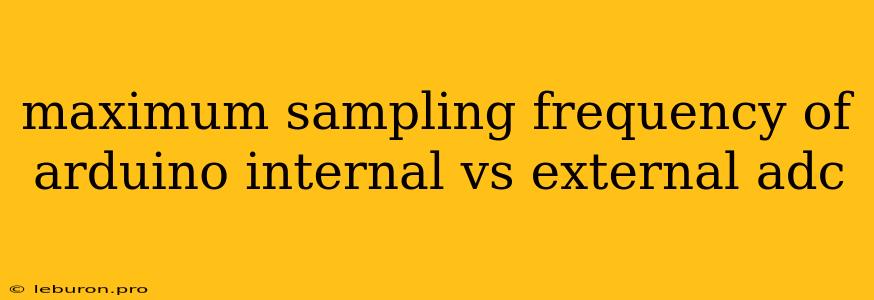The Arduino platform is renowned for its accessibility and versatility, enabling hobbyists and professionals alike to create a wide range of projects. One of the key functionalities offered by Arduino is the Analog-to-Digital Converter (ADC), which allows the conversion of analog signals to digital values for processing. Understanding the maximum sampling frequency of Arduino's internal vs external ADC is crucial for optimizing performance and achieving accurate results in applications involving analog signal acquisition. This article delves into the technical aspects of Arduino's ADC system, highlighting the differences between internal and external ADC, their respective sampling frequencies, and factors affecting their performance.
Internal ADC: A Built-in Solution
Arduino boards typically incorporate an internal Analog-to-Digital Converter (ADC) as an integrated component. This internal ADC is directly connected to the microcontroller's internal circuitry, allowing for convenient and efficient analog signal processing. The maximum sampling frequency of the internal ADC varies depending on the specific Arduino board model. For example, the Arduino Uno, a widely popular board, has an internal ADC with a maximum sampling frequency of 15 kilohertz (kHz). This means that the ADC can convert analog signals into digital values up to 15,000 times per second.
Factors Affecting Internal ADC Sampling Frequency
Several factors can influence the maximum sampling frequency of Arduino's internal ADC. These factors include:
-
Microcontroller Architecture: Different microcontroller architectures used in Arduino boards have varying ADC capabilities. Some microcontrollers may support higher sampling frequencies compared to others.
-
ADC Resolution: The resolution of the internal ADC determines the number of bits used to represent the converted analog signal. A higher resolution ADC typically has a lower sampling frequency. This trade-off between resolution and speed is inherent to ADC technology.
-
Conversion Time: The conversion time refers to the time it takes for the ADC to convert an analog signal into a digital value. The conversion time directly affects the maximum sampling frequency, as a longer conversion time limits the number of samples that can be acquired per second.
-
Software Overhead: Arduino's software libraries and code execution can also contribute to overhead, potentially affecting the maximum sampling frequency achievable. Optimizing code and minimizing delays can help maximize sampling performance.
External ADC: Expanding Capabilities
While the internal ADC offers convenient integration, it may not always meet the requirements of demanding applications requiring higher sampling frequencies. In such cases, an external ADC provides a solution to overcome the limitations of the internal ADC. An external ADC is a separate component that can be connected to an Arduino board via communication protocols like SPI or I2C. These external ADCs are typically specialized chips designed for high-speed analog-to-digital conversion, allowing for significantly higher sampling rates compared to the internal ADC.
Advantages of External ADCs
-
Higher Sampling Frequency: External ADCs are capable of achieving much higher sampling frequencies, often exceeding 1 megahertz (MHz) or even gigahertz (GHz) in some cases. This high-speed capability enables the acquisition of fast-changing analog signals, such as those encountered in audio, video, or sensor applications.
-
Improved Resolution: External ADCs typically offer higher resolution than the internal ADC, providing more accurate analog-to-digital conversion. This can be crucial for applications requiring precise measurements or signal analysis.
-
Flexible Configuration: External ADCs often offer flexible configuration options, allowing users to adjust parameters like sampling frequency, resolution, and input range according to their application needs.
Disadvantages of External ADCs
-
Increased Complexity: Using external ADCs introduces additional complexity to the system, requiring the user to understand communication protocols and configure the external ADC chip.
-
Higher Cost: External ADCs are typically more expensive than the internal ADC, as they are specialized components requiring higher performance capabilities.
-
Increased Board Space: External ADCs require additional space on the Arduino board, which may be a concern for projects with limited space availability.
Choosing the Right ADC: Internal or External?
The decision to use an internal or external ADC ultimately depends on the specific application requirements and available resources. If the maximum sampling frequency of the internal ADC meets the project needs and the required accuracy is achievable with the internal ADC, then using the internal ADC is a simpler and more cost-effective solution. However, if the application requires higher sampling rates, improved accuracy, or flexible configuration options, an external ADC may be necessary.
Conclusion
The maximum sampling frequency of Arduino's internal vs external ADC is a critical factor to consider when working with analog signals. The internal ADC offers convenience and affordability, while the external ADC provides higher performance capabilities but comes with increased complexity and cost. By carefully evaluating the application requirements, users can choose the appropriate ADC option that balances performance, cost, and complexity. Understanding the limitations and capabilities of both internal and external ADCs is essential for optimizing Arduino projects involving analog signal acquisition.
